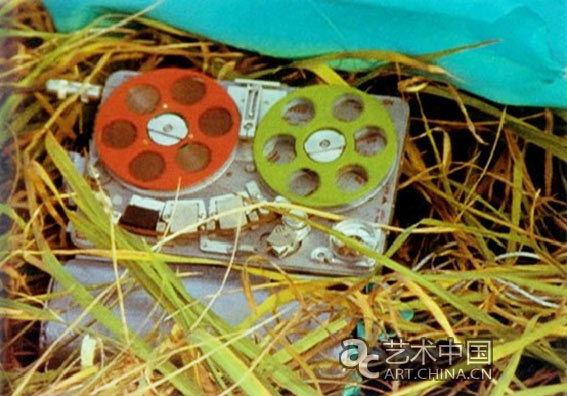史蒂夫麥奎因-《獵物》 |
| 藝術中國 | 時間: 2010-01-29 18:28:28 | 文章來源: 藝術中國 |
|
Steve McQueen Prey 1999 16mm film transferred to DVD, 6 minutes 19 seconds Dimensions variable 史蒂夫.麥奎因 獵物,1999 16mm膠片轉成DVD格式播放,6分19秒 尺寸變量
史蒂夫?麥奎因(Steve McQueen)的電影《獵物》是一個富有節奏、充滿深刻詩意的作品,作品雖然艱澀難懂,但卻引人注目。不過,逼真的躲避和逃離表演,是電影至關重要的設計。正如作品標題表明的那樣,作品玩弄了捕獲和逃脫的概念。電影開始,是帶有兩個大卷盤的盤式磁帶錄音機的特寫鏡頭,卷盤一紅一綠,擺放在夏日的草地上。踢踏舞的錄音正從磁帶上播出,但幾乎爆裂出來的踢踢踏踏的噪音,可能讓你聯想到從怪異的莫爾斯電碼到蝙蝠的聲納反射或者可能是無節奏敲鼓的任何東西。在前一半大約6分鐘的電影中,我們近距離地觀看到錄音機的磁帶不停地旋轉——一種平滑運動,連同錄音機里的踢踏聲一起, 既是聲音的一種清晰呈現,又是一種不太協調的對比。突然,磁帶錄音機似乎不受約束地開始移動,逐漸從觀眾眼前后退。隨著鏡頭的推移,錄音機跌跌撞撞地沿著不平坦的草地跑了幾秒鐘,然后開始起飛,在即將飛起之時,我們才意識到它是系在一個小的氣象氣球上。錄音機帶著噪音,在明亮的白色天空中越飛越遠,然后慢慢地消失——從聽覺上和視覺上——延續到電影的后一半。最后,就在磁帶錄音機幾乎消失的當兒,它開始打開降落傘返回地面,攝像機的角度又一次下降到與草地同一水平。隨著電影重新開始循環也再一次開始。 包括藝術家在1999年的特納獎展覽在內,這部電影在一定程度上是對豐富原色的嘗試性介入:紅色來自一盤磁帶,綠色則來自另一盤磁帶、周圍的草地以及放在附近的帶藍色的綠塑料袋。磁帶在電影播放中途逃離觀眾也含有逃避這些豐富色彩的意義;物體逃避到帶有淡藍色的白色天空中,有人可能認為,這是逃進了藝術的抽象概念之中。 電影放映使用寬銀幕,高度在觀眾之上,因此,隨著磁帶升上天空,觀眾必須仰頭凝視。正如藝術家所言,“我想讓人們置身于這樣一種場景:他們在觀看影片時對于自己非常敏感。”1在這種情況下,這部電影的身體性連同由聲音創造出來的近乎雕刻一般的距離特征——近和遠——在觀眾中間加劇了一種類似于欲望的感覺:我們想讓物體回到身邊。 這種欲望構成了麥奎因一系列靈活決定的一部分,他把觀眾放在不成功的獵人的位置。同時,這部電影與野生動物紀錄片具有某些相似之處——搖擺不定的攝像機蹲放在草地上,觀察著它陌生的獵物—— 踢踏舞者的聲音似乎暗示著有人企圖“誘捕”錄音帶中的舞者。磁帶錄音機本身就是中央情報局和聯邦調查局使用的符號:是生硬的權力機器(人們可以把電影攝像機歸入其中的一個)的另一個指標,他們試圖確定像跳舞這樣忽發奇想的快樂的活動的本質——弗萊德?阿斯泰爾(Fred Astaire)和金格爾?羅杰斯(Ginger Rogers)那敏捷的會飛的雙腳也許從來不會沾地。抽象的聲音可能已經被錄音機所捕獲,但隨著腳碰地板的聲音飛逝在天空中,這仿佛是舞者的腳在嘲笑這種世俗的想把他們捆住的企圖。 勞拉?麥克利恩?法里斯 1.‘讓我們變得更加更加關心身體’(Let’s get physical),麥奎因接受藝術月刊帕塔利西亞?比克斯(Patricia Bickers)的采訪(1996年12月-1997年1月) Steve McQueen Steve McQueen’s film Prey is a rhythmic, deeply poetic work, elusive, yet compelling to watch. The very act of eluding and evading, however, is a device central to the film, playing, as the title indicates, with concepts of capture and escape. The film begins with a close-up of a reel-to-reel tape recorder with two large spools, one red and one green, lying in long summery grass. A sound recording of tap-dancing is playing from the reels, but the clicking, almost popping, noise could be anything from an unearthly Morse code to the sonar echo of a bat or perhaps an arrhythmic drumbeat. For roughly the first half of this six-minute film, we closely watch the tape recorder’s reels spin around – a smooth motion, which, together with the tippity-tap recording, is both a visualisation of the sound and an incongruous contrast. Suddenly, the tape recorder appears to move, independently, retreating from the viewer. As the camera follows, the recorder bumbles along the uneven grass for a few seconds before taking off, at which point we realise that it is attached to a small weather balloon. The recorder, with the noise that it carries, retreats off into the bright white sky, slowly disappearing – audibly and visibly – for the last half of the film. At the end, when it has all but disappeared, the tape recorder begins to parachute back to earth, and the camera’s angle drops to grass-level once more. The cycle begins again as the film restarts. Included in the artist’s 1999 Turner Prize exhibition, to some extent the film is a foray into rich primary colour: red from one tape reel, green from the other reel, the surrounding grass and a bluish-green plastic bag that lies nearby. The flight from the viewer halfway through the film also involves a flight from these rich colours; the object flies away into a white sky tinged with baby blue, and, one might argue, into an almost painterly abstraction. The film is projected large, and at some height above the viewer, so that one must gaze upwards as the tape recorder rises into the sky. As the artist has said, ‘I want to put people into a situation where they’re sensitive to themselves watching the piece.’ In this case, the physicality of the film, together with the almost sculptural qualities of distance – near and far – created by the sound, exacerbates a sense in the viewer that is almost akin to a desire: we want the object to return to us. This desire forms part of a series of subtle decisions by McQueen that put the viewer in the position of unsuccessful hunter. Whilst the film bears some similarity to wildlife documentaries – the unsteady camera crouched in the grass, observing its strange quarry – the sound of the tap dancer seems to suggest that an attempt has been made to ‘trap’ the dancer within the recording. The tape recorder itself is of a type used by the CIA and FBI: a further indicator of blunt machines of authority (and one can include the film camera as one of these) attempting to pin down the essence of a flighty, joyous activity like dance – the swift, flying feet of Fred Astaire and Ginger Rogers perhaps, which never touch the ground. The abstract sound might have been captured by the recorder, but as the sound of foot hitting floor flies away into the sky, it is almost as though the dancers’ feet mock this earthly attempt to strap them down. Laura McLean-Ferris |
| 注:凡注明 “藝術中國” 字樣的視頻、圖片或文字內容均屬于本網站專稿,如需轉載圖片請保留 “藝術中國” 水印,轉載文字內容請注明來源藝術中國,否則本網站將依據《信息網絡傳播權保護條例》維護網絡知識產權。 |
